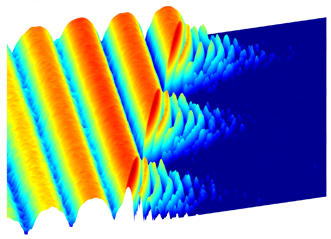
Photons Act Like Liquid, Crystal in Experiment
A system for “crystallizing” photons could help answer fundamental questions about quantum physics.
In an effort to develop exotic materials such as room-temperature superconductors, a team from Princeton University locked together photons so that they became solidly fixed in place.
“Here we set up a situation where light effectively behaves like a particle in the sense that two photons can interact very strongly,” said professor Dr. Hakan Tureci. “In one mode of operation, light sloshes back and forth like a liquid; in the other, it freezes.”

Oscillations of photons create an image of frozen light. On the left, photons flow easily between two superconducting sites. The light was later frozen to trap the photons in place. Courtesy of Princeton University.
To produce the results, the researchers created a superconducting artificial atom, which was placed near a superconducting wire containing photons. The photons inherited some of the properties of the artificial atom and essentially linked together.
“We have used this blending together of the photons and the atom to artificially devise strong interactions among the photons,” said Darius Sadri, a postdoctoral researcher at Princeton. “These interactions then lead to completely new collective behavior for light — akin to the phases of matter, like liquids and crystals, studied in condensed matter physics.”
The new device is relatively small now, but expanding it and the number of interactions could increase the ability to simulate complex quantum systems. The new approach could help the researchers better understand atoms and molecules, and their potential use in quantum computers.
“The goal is to better understand current materials and processes, and to evaluate materials that we cannot yet create,” Tureci said.
The work was funded by the Eric and Wendy Schmidt Transformative Technology Fund, the National Science Foundation, the David and Lucile Packard Foundation, the U.S. Army Research Office and the Swiss National Science Foundation.
The research was published in Physical Review X (doi: 10.1103/PhysRevX.4.031043).
For more information, visit www.princeton.edu.
Published: September 2014